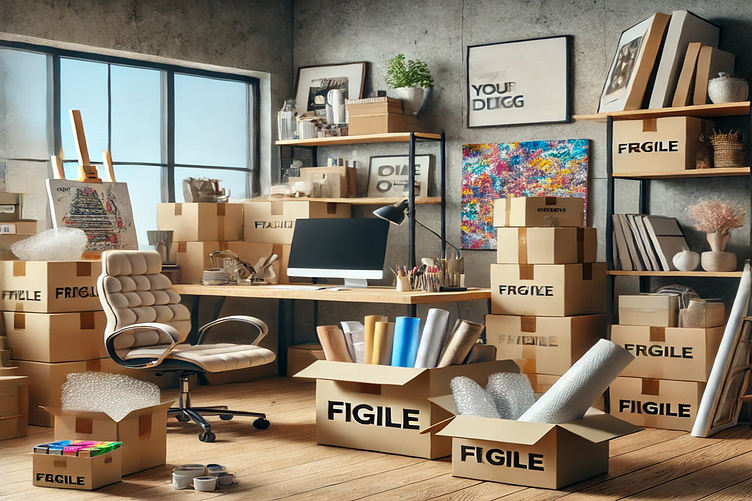Expert Tips for Designers on Relocating Their Workspace
This design is generated with the help of ChatGPT
Relocating your workspace as a designer can feel like both an exciting opportunity and an overwhelming challenge. Whether upgrading to a larger studio or streamlining your workflow in a new location, moving your creative workspace involves meticulous planning, a keen eye for detail, and the ability to preserve your artistic flow. One crucial aspect often overlooked in this process is packing artwork for moving, a delicate yet essential part of transitioning as a designer.
To help you navigate this process seamlessly, this guide offers expert insights and actionable tips for relocating your workspace effectively.
Why Relocation is a Fresh Start for Designers
Moving to a new workspace can symbolize the start of a fresh creative chapter. A new environment often fosters inspiration, helping designers break free from old habits and embrace innovation. However, this potential can only be unlocked if the transition is smooth. From organizing your tools to ensuring your artwork arrives intact, planning is vital for minimizing disruption to your creative process.
The Emotional Connection to Your Workspace
For designers, a workspace is more than a physical area; it's a sanctuary for creativity. Moving means not just transporting objects but also recreating the environment that inspires and motivates. Understanding this emotional connection can help guide decisions during the relocation process.
Recognizing the Impact of Space on Creativity
Every element, from lighting to furniture arrangement, contributes to a designer’s productivity. Relocating offers an opportunity to assess what works and identify improvements. While packing artwork for moving, think ahead about how the new setup can better serve your creative flow.
Step-by-Step Guide to Preparing for a Move
Thorough preparation is essential to ensure your workspace relocation is successful. Here’s how to approach it:
1. Evaluate Your Current Setup
Before diving into boxes and bubble wrap, take time to assess your current workspace. Identify what needs to stay, what can be upgraded, and what is no longer useful. This step not only reduces clutter but also sets the tone for an organized move.
2. Organize and Categorize
Divide your workspace into categories: tools, artwork, reference materials, and furniture. This systematic approach makes it easier to pack and unpack. For instance, when packing artwork for moving, ensure you have protective materials ready for fragile or valuable pieces.
3. Create a Moving Timeline
Set realistic deadlines for packing and relocating. This timeline should allow enough flexibility for unexpected challenges while keeping the process efficient.
4. Prepare a Packing Station
Set up a designated area for packing. Having all supplies—such as boxes, tape, and bubble wrap—in one place can save time and reduce stress.
5. Label Everything Clearly
Proper labeling is your best friend during a move. Each box should indicate its contents and the room it belongs in. This step simplifies unpacking and minimizes misplaced items.
Best Practices for Designers: Packing Artwork for Moving
Artwork is often the heart of a designer’s workspace, requiring special care during a move. Follow these tips to ensure your creations remain pristine:
1. Use Professional-Grade Packing Materials
Invest in sturdy boxes, acid-free paper, bubble wrap, and corner protectors. These materials provide the best defense against damage during transit.
2. Pack Similar Items Together
Group similar items, such as framed pieces, sculptures, or canvases. This reduces the risk of damage caused by incompatible materials being packed together.
3. Secure Frames and Edges
Framed artwork requires extra attention. Wrap each piece individually, using corner protectors to prevent damage to the frames. Use packing tape sparingly to avoid adhesive marks.
4. Label Fragile Items Clearly
Mark boxes containing delicate or high-value pieces as “FRAGILE” to ensure extra care during the move.
5. Opt for Climate-Controlled Transport
Extreme temperatures and humidity can damage artwork. Choose a moving service that offers climate-controlled options to safeguard your valuable creations.
Designing Your New Workspace: A Blueprint for Success
Once you’ve relocated, the real excitement begins—designing your new workspace. A well-thought-out setup can elevate your creativity and productivity.
1. Prioritize Natural Light
Lighting is a cornerstone of a designer's workspace. Position your desk and tools to take advantage of natural light, which reduces eye strain and enhances focus.
Maximizing Space
Optimize every inch of your new studio. Use vertical storage solutions to keep supplies organized while preserving floor space.
Incorporating Ergonomics
Select furniture and equipment that promote comfort and efficiency. An ergonomic desk and chair setup can improve posture and reduce physical strain.
Managing Logistics with Professional Help
Why Hiring Experts Can Save Time and Stress
Relocating a workspace involves numerous moving parts. Entrusting the process to professionals with experience in handling delicate and valuable items allows designers to focus on their craft rather than logistical details.
Common Challenges and How to Overcome Them
Relocating a designer’s workspace can be daunting. Anticipating potential challenges can help you stay prepared.
Challenge 1: Maintaining Workflow During the Move
Set up a temporary workspace to ensure continuity in your creative projects.
Challenge 2: Adapting to a New Environment
Give yourself time to acclimate to the new space. Gradually personalize it to make it feel like home.
Insights from the Experts
For additional insights into optimizing your workspace and maintaining creativity, platforms likeThe Spruce offer expert advice on organizing, designing, and enhancing spaces. Their focus on home and office design provides valuable inspiration for creating an efficient and inspiring workspace without directly involving moving services.
Embrace the Art of Moving
Relocating your workspace is a complex yet rewarding process. With careful planning, a focus on preserving your creative flow, and expert tips on packing artwork for moving, you can make the transition smooth and inspiring. Whether relocating down the street or across the country, the key lies in balancing logistics with creativity to craft a workspace that fuels your best work.
